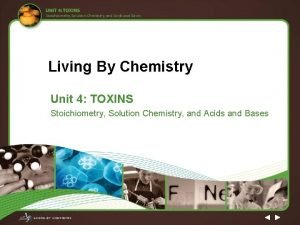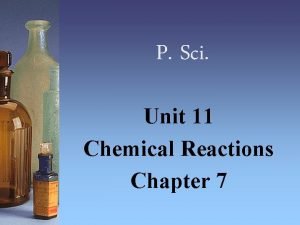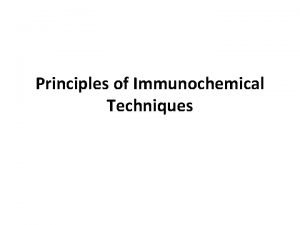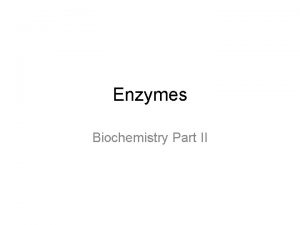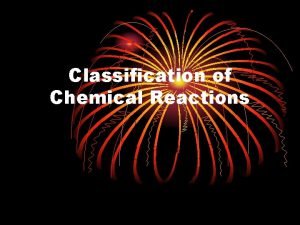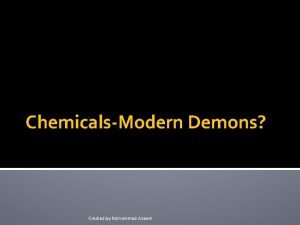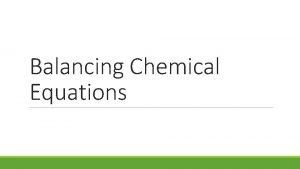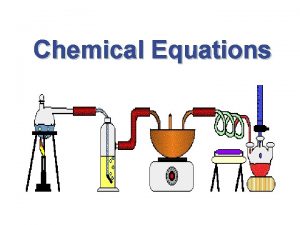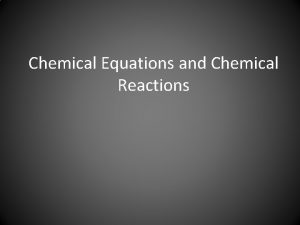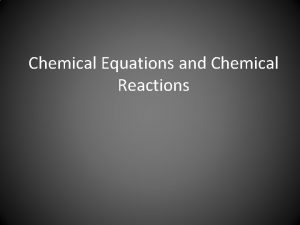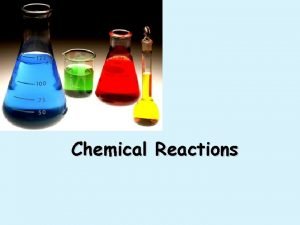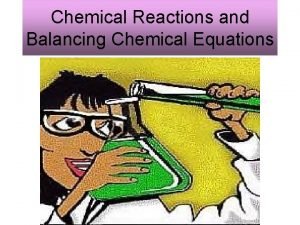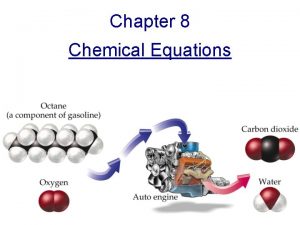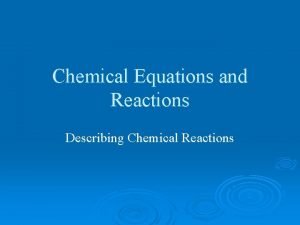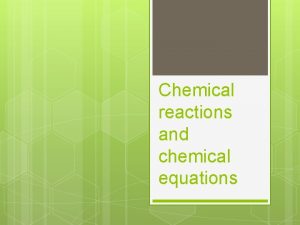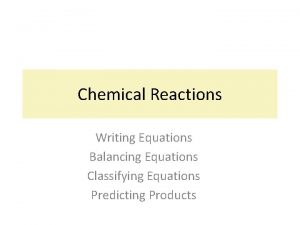Unit 6 Chemical Reactions Chemical Equations Chemical reactions






































- Slides: 38


Unit 6 Chemical Reactions:

Chemical Equations �Chemical reactions are described by chemical equations �Chemical equations are symbols and formulas what is taking place within a reaction.

Reading and Writing Chemical Equations: 3 requirements 1. Equation must represent the known facts (the reactants and products must be identified) 2. Equation must contain the correct formulas (oxidation numbers play a role here) 3. Law of conservation of mass must be satisfied (atoms are neither created nor destroyed in ordinary chemical reactions) To equalize numbers atoms, coefficients are added when necessary

�Coefficients: are small whole numbers that appear in front of a formula in a chemical reaction

Significance of a chemical equation �Chemical equations can be interpreted quantitatively in 3 ways: 1. Ratios of reactants and products 2. Reverse Reactions

3. Amount of reactants and Products �Chemical equations generally show the smallest numbers of atoms/molecules/ions that will satisfy the law of conservation of mass �Chemical equations provide information about moles and masses of reactant and products �

Example �Shows: 1. 2 molecule of H reacts with 1 molecule of O to yield 2 molecules of H 2 O � 2 moles of H reacts with 1 moles of O to yield 2 moles of H 2 O � 2 grams of H reacts with 1 gram of O to yield 2 grams of H 2 O

Important information not provided by chemical equations 1. No indication of whether or not a reaction will occur. 2. No information about speed with which reactions occur or the pathway the atoms take from reactant to product

Turn Word Equations into Balanced Equations • If you don’t transform your word into a skeleton equation properly, you won’t be able to balance the equation correctly. • Be careful of diatomic elements - remember the special seven!! seven H 2, N 2, O 2, F 2, Cl 2, Br 2, I 2 See page 208 (c) Mc. Graw Hill Ryerson 2007

• Word equation: any equation in which the reactants and products in a chemical reaction are represented by words. • Ex methane + oxygen carbon dioxide + water • Word equations do not give the quantities of reactants used or produced formed

• the arrow (--->) means reacts to yield or yields • Formula equation: represents the reactants and products of the chemical reaction by their symbols or formulas

Change chemical names into chemical formulas. 4 types: types 1. 2. 3. 4. Simple ionic compounds Multivalent ionic compounds Ionic compounds with polyatomic ions Covalent compound

Turn Word Equations into Balanced Equations w Several common covalent molecules containing hydrogen have common names that you should know and MEMORIZE!! §methane = CH 4 §glucose = C 6 H 12 O 6 §ethane = C 2 H 6 §ammonia = NH 3 See page 208 (c) Mc. Graw Hill Ryerson 2007

Turn Word Equations into Balanced Equations Example #1: Word Equation: Solutions of lead nitrate react with potassium iodide to produce solid lead iodide and a solution of potassium nitrate. Skeleton Equation: Pb(NO 3)2(aq) + KI(aq) Pb. I 2(s) + KNO 3(aq) Balanced Equation: Pb(NO 3)2(aq) + 2 KI(aq) Pb. I 2(s) + 2 KNO 3(aq) See page 208 (c) Mc. Graw Hill Ryerson 2007

• Example #2: • Word Equation: Copper reacts with hydrogen nitrate to produce copper (II) nitrate plus hydrogen. • Skeleton Equation: Cu + H(NO 3) • Balanced Equation: Cu + 2 H(NO 3) H 2 Cu(NO 3)2 + H 2 Cu(NO 3)2 +


• Catalyst: a substance that speeds up a chemical reaction but is not permanently consumed in the reaction. • Reversible reaction: is a chemical reaction in which the products reform the original reactants

BALANCING EQUATIONS

�Chemical reactions involve a rearrangement of the ways atoms are grouped together. • A chemical equation represents a chemical reaction. § Reactants are shown to the left of the arrow. § Products are shown to the right of the arrow. Copyright © Cengage Learning. All rights reserved 20

�In a chemical reaction atoms are not created or destroyed. • All atoms present in the reactants must be accounted for in the products. § Same number of each type of atom on both sides of the arrow. § Thus Equations must be balanced 21

Law of Conservation of Mass • When a chemical reaction occurs, new compounds are created, BUT… – No new matter is created or destroyed; destroyed atoms are just rearranged as the atoms change partners to form new compounds. – If there are 3 atoms of oxygen in the reactants, there MUST be 3 atoms of oxygen in the products. – Number of each atom in reactants = number of each atom in products. • The law of conservation of mass: – Mass of reactants = mass of products If you could collect and measure all of the exhaust from this car, you would find that mass of reactants (gas + O 2) = mass of products (exhaust). (c) Mc. Graw Hill Ryerson 2007

How to Write and Balance Equations 1. Read the description of the chemical reaction. What are the reactants, the products, and their states? Write the appropriate formulas. Hydrogen gas (H 2) and oxygen gas (O 2) combine to form liquid water (H 2 O). 2. Write the unbalanced equation that summarizes the information from step 1. H 2(g) + O 2(g) H 2 O(l) Copyright © Cengage Learning. All rights reserved 23

How to Write and Balance Equations 3. Balance the equation by inspection, starting with the most complicated molecule. Equation is unbalanced by counting the atoms on both sides of the arrow. Copyright © Cengage Learning. All rights reserved 24

How to Write and Balance Equations 3. Balance the equation by inspection, starting with the most complicated molecule. We must balance the equation by adding more molecules of reactants and/or products. Copyright © Cengage Learning. All rights reserved 25

How to Write and Balance Equations 4. Check to see that the coefficients used give the same number of each type of atom on both sides of the arrow. Also check to see that the coefficients used are the smallest integers that give the balanced equation. The balanced equation is: 2 H 2(g) + O 2(g) 2 H 2 O(l) preferred or could be: 4 H 2(g) + 2 O 2(g) 4 H 2 O(l) Copyright © Cengage Learning. All rights reserved 26

Another Balancing Example: Copyright © Cengage Learning. All rights reserved 27

Balancing using the underline method. Na 2 O(s) + H 2 O(l) 2 Na. OH(aq) CH 4(g) + 2 O 2(g) CO 2(g) + 2 H 2 O(g) 42 Fe(s) + 3 O 2(g) 2 Fe 2 O 3(s) Li. OH(s) + CO 2(g) 2 KCl. O 3(s) Copyright © Cengage Learning. All rights reserved 28 D Li. HCO 3(s) 2 KCl(s) + 3 O 2(g) Mn. O 2

Balancing Example: Copyright © Cengage Learning. All rights reserved 29

Writing & Balancing Equations • The simplest form of chemical equation is a word equation. – Potassium metal + oxygen gas potassium oxide • A skeleton equation shows the formulas of the elements/compounds. – A skeleton equation shows which atoms are involved, but not how many molecules are involved. • K + O 2 K 2 O

Writing & Balancing Equations • A balanced chemical equation shows all atoms and the coefficients tells us how many molecules (and atoms) there are. – Balancing ensures that the number of each atom is the same on both sides of the reaction arrow. 4 K K K + O 2 O O 2 K 2 O K K O K

Counting Atoms to Balance Equations • Using the law of conservation of mass, we can count atoms to balance the number of atoms in chemical equations. – Word equation: methane + oxygen water + carbon dioxide – Skeleton equation: CH 4 + O 2 H 2 O + CO 2 • To balance the compounds, take note of how many atoms of each element occur on each side of the reaction arrow. (c) Mc. Graw Hill Ryerson 2007 See Page 207

Counting Atoms to Balance Equations Skeleton equation: The same number of atoms must be on each side. Balanced equation: (c) Mc. Graw Hill Ryerson 2007 CH 4 + O 2 H 2 O + CO 2 Carbon = 1 Hydrogen = 4 Oxygen = 2 Carbon = 1 Hydrogen = 2 Oxygen = 3 CH 4 + 2 O 2 2 H 2 O + CO 2 Carbon = 1 Hydrogen = 4 Oxygen = 4 See Page 207

Balancing Equations hydrogen H 2 H O + oxygen O 2 + water H 2 O Reactants 2 Products 2 2 1

Balancing Equations + oxygen hydrogen peroxide X hydrogen H 2 + O 2 H 2 O 2 YOU CANNOT CHANGE THE SUBSCRIPTS H O Reactants 2 2 Products 2 2

Balancing Equations hydrogen + oxygen H 2 + H O O 2 Reactants 2 2 water 2 H 2 O Products 2 1

Balancing Equations hydrogen + oxygen H 2 + H O O 2 Reactants 2 2 water 2 H 2 O Products 4 2

Balancing Equations hydrogen + oxygen 2 H 2(g) + H O water O 2 (g) 2 H 2 O (l) Reactants 4 2 Products 4 2
 Section 2 classifying chemical reactions worksheet answers
Section 2 classifying chemical reactions worksheet answers Section 2 classifying chemical reactions worksheet answers
Section 2 classifying chemical reactions worksheet answers Chapter 18 chemical reactions balancing chemical equations
Chapter 18 chemical reactions balancing chemical equations Unit 5 chemical equations and reactions
Unit 5 chemical equations and reactions Unit 5 chemical equations and reactions
Unit 5 chemical equations and reactions Chemical reactions section 3 reactions in aqueous solutions
Chemical reactions section 3 reactions in aqueous solutions Chemistry unit 5 reactions balancing reactions worksheet
Chemistry unit 5 reactions balancing reactions worksheet Lesson 68 toxic reactions chemical equations answer key
Lesson 68 toxic reactions chemical equations answer key Chapter 8 review chemical equations and reactions
Chapter 8 review chemical equations and reactions Chapter 8 section 1 chemical equations and reactions
Chapter 8 section 1 chemical equations and reactions Chemical equations and reactions chapter 8
Chemical equations and reactions chapter 8 Chapter 19 chemical reactions simple word equations
Chapter 19 chemical reactions simple word equations Toxic reactions chemical equations
Toxic reactions chemical equations Translate word equations to chemical equations
Translate word equations to chemical equations Section 1 chemical changes
Section 1 chemical changes Unit 11 chemical reactions
Unit 11 chemical reactions Redox reactions half reactions
Redox reactions half reactions Unit 10, unit 10 review tests, unit 10 general test
Unit 10, unit 10 review tests, unit 10 general test Polar to rectangular equation
Polar to rectangular equation Stoichiometry island diagram
Stoichiometry island diagram Types of redox reactions
Types of redox reactions How to identify types of chemical reactions
How to identify types of chemical reactions Types of reactions chemistry
Types of reactions chemistry What are the 5 types of chemical reactions
What are the 5 types of chemical reactions Predicting products of chemical reactions
Predicting products of chemical reactions 4 types of chemical reactions
4 types of chemical reactions Non examples of chemical reactions
Non examples of chemical reactions Chapter 10 chemical reactions
Chapter 10 chemical reactions The calculations of quantities in chemical reactions
The calculations of quantities in chemical reactions Ouchterlony
Ouchterlony Predicting products of chemical reactions
Predicting products of chemical reactions Predicting products synthesis
Predicting products synthesis Combination reaction equation
Combination reaction equation Four types of chemical reactions
Four types of chemical reactions Biology-roots.com
Biology-roots.com Describing chemical reactions
Describing chemical reactions Chemical reactions classification
Chemical reactions classification Chemical reactions in everyday life
Chemical reactions in everyday life What are five chemical changes
What are five chemical changes












